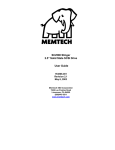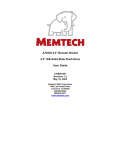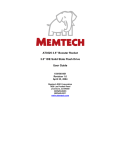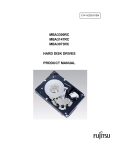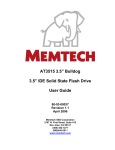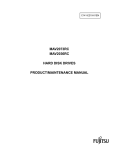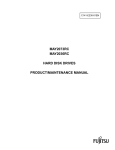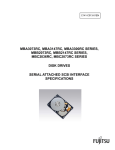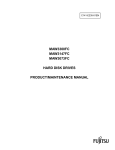Download Memtech SC3500 User guide
Transcript
SC3500 3.5” Solid State SCSI Drive User Guide 80-03-00032 Revision 1.3 March 8, 2005 Memtech SSD Corporation 7628 Las Positas Road Livermore, CA 94551 (800)445-5511 www.memtech.com Table Of Contents 1. HIGHLIGHTS .....................................................................3 2. INTRODUCTION ................................................................3 3. GENERAL DESCRIPTION.................................................4 3.1 3.2 3.3 SCSI Interface..............................................................................4 SCSI Connector ...........................................................................5 SCSI Commands .........................................................................7 4. GENERAL SPECIFICATIONS .........................................19 5. JUMPER CONFIGURATION............................................20 5.1 5.2 5.3 5.4 5.5 5.6 5.7 5.8 5.9 Jumper and Switch Locations ....................................................20 SCSI ID Selection ......................................................................21 Write Protection .........................................................................21 Termination ................................................................................21 Termination Power .....................................................................22 Parity ..........................................................................................22 Remote LED...............................................................................22 Reserved locations.....................................................................22 Memory Size ..............................................................................22 6. INSTALLATION ...............................................................23 6.1 6.2 6.3 6.4 Default Configuration .................................................................23 Hardware Installation Procedure ................................................23 Power and Cable Attachments...................................................24 Software Installation Procedure .................................................24 7. MECHANICAL DRAWINGS..............................................25 8. TROUBLE SHOOTING GUIDE ........................................27 8.1 8.2 8.3 8.4 Error Blink Codes -.....................................................................27 Warning Blink Codes –...............................................................27 Red LED on steady at power-up- ...............................................27 Unit does not respond to SCSI commands -..............................27 9. APPENDIX .......................................................................28 9.1 9.2 9.3 Contact Information....................................................................28 SCSI specification information ...................................................28 Limited Lifetime Warranty ..........................................................28 SC3500 User Guide Ver 1.3 March 8, 2005 Page 2 of 28 1. HIGHLIGHTS • • • • • • • • • • • • • • • • 36864 Mbyte uncompressed capacity o o Full -40 C to +85 C operating temp range Active Remap™ Technology with ECC Unmatched SCSI-II compatibility On-board active termination 5 volt, low power operation Completely solid state - no moving parts 500G operating shock 10G operating vibration Rugged, 3.5” half height drive form factor Single-ended 50-pin shrouded SCSI interface 0.7 millisecond random access time 2.3 Mbyte/sec sustained Read throughput 1.0 Mbyte/sec sustained Write throughput 10 year guaranteed data integrity NO installable device drivers 2. INTRODUCTION The SC3500 series is a line of 100% compatible SCSI-II solid state drives in a 3.5inch half-height format. It is completely solid state, with no moving parts. This accounts for the unit’s exceptional ruggedness and wide operating temperature range. 2 Sector Erasable NAND E PROM (Flash) are used to provide up to 36864 Mbytes of nonvolatile, solid state storage in an extremely small, rugged form factor. The drive is 100% SCSI-2 compatible direct access device and requires no special drivers to operate. It is essentially a drop in replacement for standard rotating media. The SC3500 can be used in applications where operating conditions are harsh and when reliability is critical. A 100% CMOS logic design minimizes power consumption, and the +5 volt only power requirement simplifies system supply needs. An on-board microprocessor implements all control functions, and oversees SCSI communications via a Qlogic FAS209 SCSI-II processor. The microprocessor performs all power up diagnostics, data transfers, and error handling in the unit. The SC3500 can sustain a 2.3 Mbyte per second read throughput and 1.0 Mbyte per second write throughput. The unit responds to all Direct-Access device commands, uses a single-ended, unitized 50-pin interface and as with all single-ended SCSI devices, the SC3500 may be placed up to 18 feet (6 m) from the host SCSI controller. Data integrity is maintained using Memtech’s proprietary Active Remap™ technology. The drive is available in capacities ranging from 128 Mbytes to 36864 Mbytes. Please contact the factory with your requirements. Every drive is fully tested under environmental extremes using Memtech’s Enduro Test, which guarantees data integrity under even the harshest conditions. SC3500 User Guide Ver 1.3 March 8, 2005 Page 3 of 28 3. GENERAL DESCRIPTION 3.1 SCSI Interface An intelligent SCSI controller from Qlogic, the FAS209, handles the SCSI interface for the SC3500. The FAS209 is SCSI-I and SCSI II compliant, and automates much of the interface overhead. It has a 16 byte FIFO, a DMA interface, and numerous command and control registers. The SC3500 employs the following attributes: 1. 2. 3. 4. 5. Single-ended drivers Termination power derived from cable or drive Selectable parity on the interface "Hard" RESET implemented Reservation queuing The SC3500 has implemented all mandatory SCSI-I and SCSI- II commands and several optional commands to enhance functionality. The following is a list of commands and their equivalent hexadecimal representation. 1. 2. 3. 4. 5. 6. 7. 8. 9. 10. 11. 12. 13. 14. 15. 16. 17. 18. 19. 20. 21. 22. 23. Test Unit Ready Rezero Unit Request Sense Format Unit Read Write Inquiry Mode Select Reserve Unit Release Unit Mode Sense Receive Diagnostics Send Diagnostics Read Capacity Extended Read Extended Write Erase Write & Verify Verify Read Defect Write Buffer Read Buffer Change Definition SC3500 User Guide Ver 1.3 00h 01h 03h 04h 08h 0Ah 12h 15h 16h 17h 1Ah 1Ch 1Dh 25h 28h 2Ah 2Ch 2Eh 2Fh 27h 3Bh 3Ch 40h March 8, 2005 M O M M M O M O M M O O M M M O O O O O O O O Page 4 of 28 The implemented messages on the SC3500 are as follows: 1. 2. 3. 4. 5. 6. 7. 8. 9. Command Complete Extended Message Init Detected Error Abort Message Reject NoOp Message Message Parity Error Bus Device Reset Identify 00h 01h 05h 06h 07h 08h 09h 0Ch 80h Generated Both Received Received Generated Received Received Received Received 3.2 SCSI Connector The SC3500 uses a unitized SCSI-2 connector incorporating both the 50-pin right angle 0.1 inch center connector and the 4-pin AT power connector. Maximum cable length is 6 meters. The diagram below depicts connector orientation and location. 3.2.1 SCSI Connector Physical Orientation Pin #1 +5V GND SC3500 – Connector View Fig. 1: SC3500 SCSI connector view SC3500 User Guide Ver 1.3 March 8, 2005 Page 5 of 28 3.2.2 SCSi Connector Pinout The following shows the pin connections for the SCSI connector used on the SC3500. PIN 1 3 5 7 9 11 13 15 17 19 21 23 25 27 29 31 33 35 37 39 41 43 45 47 49 SIGNAL GROUND GROUND GROUND GROUND GROUND GROUND GROUND GROUND GROUND GROUND GROUND RSVD GROUND RSVD GROUND GROUND GROUND GROUND GROUND GROUND GROUND GROUND GROUND GROUND GROUND SC3500 User Guide Ver 1.3 PIN 2 4 6 8 10 12 14 16 18 20 22 24 26 28 30 32 34 36 38 40 42 44 46 48 50 SIGNAL DB0 DB1 DB2 DB3 DB4 DB5 DB6 DB7 DBP GROUND GROUND RSVD TERMPWR RSVD GROUND ATN GROUND BSY ACK RST MSG SEL C/D REQ I/O March 8, 2005 Page 6 of 28 3.3 SCSI Commands 3.3.1 Test Unit Ready Command – 00h Test Unit Ready CDB The TEST UNIT READY command provides a means to check if the logical unit is ready. This is not a request for a self-test. If the logical unit would accept an appropriate medium-access command without returning CHECK CONDITION status, this command shall return a GOOD status. If the logical unit cannot become operational or is in a state such that an initiator action is required to make the unit ready, the target shall return CHECK CONDITION status with a sense key of NOT READY. 3.3.2 Rezero Unit Command – 01h Rezero Unit CDB The REZERO UNIT command requests that the target set the logical unit to a specific state. This is implemented on the SC3500 as a NOP command and has no effect other than to verify the CDB. SC3500 User Guide Ver 1.3 March 8, 2005 Page 7 of 28 3.3.3 Request Sense Command – 03h Request Sense CDB The REQUEST SENSE command requests that the SC3500 transfer sense data to the initiator. If the SC3500 has no sense data available to return, it will return a sense key of NO SENSE and an additional sense code of NO ADDITIONAL SENSE INFORMATION. The sense data shall be preserved by the target for the initiator until retrieved by a REQUEST SENSE command or until the receipt of any other I/O process for the same I_T_x nexus. Sense data shall be cleared upon receipt of any subsequent I/O process (including REQUEST SENSE) to the same I_T_x nexus. The target shall return CHECK CONDITION status for a REQUEST SENSE command only to report exception conditions specific to the command itself. For example: a) A non-zero reserved bit is detected in the command descriptor block; b) An unrecovered parity error is detected on the data bus; c) A target malfunction prevents return of the sense data. If a recovered error occurs during the execution of the REQUEST SENSE command, the target shall return the sense data with GOOD status. If a target returns CHECK CONDITION status for a REQUEST SENSE command, the sense data may be invalid. The SC3500 is capable of returning eighteen bytes of data in response to a REQUEST SENSE command. If the allocation length is eighteen or greater, and the SC3500 returns less than eighteen bytes of data, the initiator should assume that the bytes not transferred would have been zeros had the target returned those bytes. Initiators can determine how much sense data was returned by examining the allocation length parameter in the command descriptor block and the additional sense length in the sense data. The sense data format for error codes 70h (current errors) and 71h (deferred errors) are defined below. For further details on the Request Sense command, please refer to the SCSI specification. SC3500 User Guide Ver 1.3 March 8, 2005 Page 8 of 28 Sense data format SC3500 User Guide Ver 1.3 March 8, 2005 Page 9 of 28 3.3.4 Format Unit Command – 04h The FORMAT UNIT command formats the medium into initiator addressable logical blocks per the initiator-defined options. In addition, the medium may be certified and control structures may be created for the management of the medium and defects. Format Unit CDB Only the simplest and mandatory forms of the FORMAT UNIT command (with no format data) are implemented on the SC3500. This routine accomplishes medium formatting with little initiator control over defect management. The FORMAT UNIT command shall be rejected with RESERVATION CONFLICT status if the logical unit is reserved, or any extent reservation, from any initiator, is active in the specified logical unit. During the execution of the FORMAT UNIT command, the SC3500 may perform a medium defect management algorithm. A FmtData bit of zero indicates that a DATA OUT phase shall not occur. The source of defect information is not specified. This is the only form of the command the SC3500 supports. A complete list (CmpLst) bit of one indicates that the defect list sent by the initiator is a complete list of defects. The existing defect list is discarded by the SC3500 and a new primary defect list is constructed. A CmpLst bit of zero indicates that the current defect list should be maintained. As a result a new primary is constructed that contains the existing list and any new defects the SC3500 may add during the format operation. SC3500 User Guide Ver 1.3 March 8, 2005 Page 10 of 28 3.3.5 Read (6) Command – 08h The READ (6) command requests that the SC3500 transfer data to the initiator. The most recent data value written in the addressed logical block shall be returned. Read (6) CDB The logical block address field specifies the logical block at which the read operation shall begin. The transfer length field specifies the number of contiguous logical blocks of data to be transferred. A transfer length of zero indicates that 256 logical blocks shall be transferred. Any other value indicates the number of logical blocks that shall be transferred. 3.3.6 Write (6) Command – 0Ah The WRITE (6) command requests that the target write the data transferred by the initiator to the medium. Write (6) CDB The logical block address field specifies the logical block at which the write operation shall begin. The transfer length field specifies the number of contiguous logical blocks of data to transfer. A transfer length of zero indicates that 256 logical blocks shall be transferred. Any other value indicates the number of logical blocks that shall be transferred. SC3500 User Guide Ver 1.3 March 8, 2005 Page 11 of 28 3.3.7 Inquiry Command – 12h The INQUIRY command requests that information regarding parameters of the SC3500 be sent to the initiator. Inquiry CDB An enable vital product data (EVPD) bit of one specifies that the SC3500 return the optional vital product data specified by the page code field. If any optional fields in the CDB are set that the SC3500 does not support, it will return a CHECK CONDITION status with the sense key set to ILLEGAL REQUEST and an additional sense code of INVALID FIELD IN CDB. An EVPD bit of zero specifies that the SC3500 return the standard INQUIRY data. If the page code field is not zero, the target shall return CHECK CONDITION status with the sense key set to ILLEGAL REQUEST and an additional sense code of INVALID FIELD IN CDB. The page code field specifies which page of vital product data information the SC3500 return. The INQUIRY command shall return CHECK CONDITION status only when the target cannot return the requested INQUIRY data. The INQUIRY data should be returned even though the peripheral device may not be ready for other commands. If an INQUIRY command is received from an initiator with a pending unit attention condition, the SC3500 will perform the INQUIRY command and not clear the unit attention condition. SC3500 User Guide Ver 1.3 March 8, 2005 Page 12 of 28 Standard Inquiry Data Format Please refer to the SCSI specification for further details on the vital product data pages and formats. SC3500 User Guide Ver 1.3 March 8, 2005 Page 13 of 28 3.3.8 Reserve Unit – 16h The RESERVE command is used to reserve a logical unit or, if the extent reservation option is implemented, extents within a logical unit. Reserve CDB 3.3.9 Release Unit – 17h The RELEASE command is used to release a previously reserved logical unit, or, if the extent release option is implemented, to release previously reserved extents within a logical unit. Release CDB SC3500 User Guide Ver 1.3 March 8, 2005 Page 14 of 28 3.3.10 Mode Sense The MODE SENSE (6) command provides a means for a target to report parameters to the initiator. It is a complementary command to the MODE SELECT (6) command. Mode Sense CDB A disable block descriptors (DBD) bit of zero indicates that the target may return zero or more block descriptors in the returned MODE SENSE data, at the target’s discretion. A DBD bit of one specifies that the target shall not return any block descriptors in the returned MODE SENSE data. The page control (PC) field defines the type of mode parameter values to be returned in the mode pages. The page code specifies which mode page to return. SC3500 User Guide Ver 1.3 March 8, 2005 Page 15 of 28 3.3.11 Send Diagnostics – 1Dh The SEND DIAGNOSTIC command requests that the SC3500 perform diagnostic operations on itself. The only mandatory implementation of this command is the self-test feature with the parameter list length of zero. Send Diagnostics CDB 3.3.12 Read Capacity – 25h The READ CAPACITY command provides a means for the initiator to request information regarding the capacity of the logical unit. Read Capacity CDB SC3500 User Guide Ver 1.3 March 8, 2005 Page 16 of 28 3.3.13 Extended Read (10) – 28h The READ (10) command requests that the target transfer data to the initiator. The most recent data value written in the addressed logical block is returned. Read (10) CDB 3.3.14 Extended Write (10) The WRITE (10) command requests that the SC3500 write the data transferred by the initiator to the medium. Write (10) CDB SC3500 User Guide Ver 1.3 March 8, 2005 Page 17 of 28 3.3.15 Erase Command Erase CDB The ERASE (10) command requests that the target erase the specified number of blocks starting at the specified logical block address on the medium. As used here, erased means the medium shall be erased. The previous data recorded on the medium, if any, shall not be recoverable. The Remap Table is retained, thus allowing write and read access to the memory. The erase all (ERA) bit set to one indicates that all blocks on the medium shall be erased. If the ERA bit is set to one and if the number of blocks is not zero, the SC3500 will return CHECK CONDITION, and the sense key shall be set to ILLEGAL REQUEST, with an additional sense code of INVALID FIELD IN CDB. If the ERA bit is zero a transfer length of zero indicates that no blocks shall be erased. This condition is not considered an error and no data is erased. Any other value indicates the number of logical blocks that shall be erased. A note about the Erase Command – The erase command has been implemented as a security erase mechanism on the SC3500. The command was originally created and used by tape backup devices. When executed with ERA set, a 1 Gbyte drive can be wiped clean in about 10 seconds. All storage locations on the drive are erased, including both user and system (protected) data areas. At the conclusion of the erase command, the existing Remap Table™ is restored to memory. SC3500 User Guide Ver 1.3 March 8, 2005 Page 18 of 28 4. GENERAL SPECIFICATIONS Interface SCSI Compatibility SCSI Device Type Maximum Capacity Bytes/Block Bus Width Termination ANSI X3.131-1994 0 - Direct Access Device 36864 Mbytes 512 8 bits Active – on board Data Transfer Specifications Bus width Synchronous Transfer Rate Media Transfer Rate Read Transfer Rate Write Transfer Rate Data Access time 1 byte (8 bits) 10 Mbyte/sec 8 Mbyte/sec 2.3 Mbyte/sec., sustained 1.0 Mbyte/sec sustained 0.7 msec Environmental Requirements Operating Ambient Temperature Commercial Extended Industrial Storage Temperature Humidity Airflow Requirements Ceiling o o 0 C to +70 C o o -20 C to +75 C o o -40 C to +85 C o o -55 C to +125 C Ambient 5% to 95% non-condensing none no limit Mechanical (Full Capacity) Length Width Min Height Drive Form Factor Mounting Considerations Max Weight 146mm (5.75 in.) 102mm (4.00 in.) 16.0mm (0.63 in.) 3.5" low profile drive None (any orientation) 18.5 ounces (525 grams) Power Requirements Vcc Supply Vdd Supply Power Idle Power Active Power Max SC3500 User Guide Ver 1.3 +5 volts +/- 5% +12 volts not used 0.50 watts 0.90 watts 1.10 watts March 8, 2005 Page 19 of 28 5. JUMPER CONFIGURATION 5.1 Jumper and Switch Locations The following diagrams show the unit and the relative jumper and switch locations. LED+ GND SCSI2 SCSI1 SCSI0 Write Protect ACT LED Termination Reserved Parity LED- Figure 2: SC3500 Front view Fig 3: SC3500 Bottom View SC3500 User Guide Ver 1.3 March 8, 2005 Page 20 of 28 5.2 SCSI ID Selection The SC3500 can use any of the 8 SCSI IDs available on the SCSI bus, although the highest priority device, SCSI ID 7, is usually reserved for the initiator. Switch selection for each SCSI ID is shown below. The SCSI Selection switch, E8, determines whether the jumper block or switch is used to select the SCSI ID. SWITCH SCSI SEL OFF OFF OFF OFF OFF OFF OFF OFF ON* ON ON ON ON ON ON ON JUMP SCSI2 X X X X X X X X OFF OFF OFF OFF ON ON ON ON JUMP SCSI1 X X X X X X X X OFF OFF ON ON OFF OFF ON ON JUMP SCSI0 X X X X X X X X OFF ON OFF ON OFF ON OFF ON SW E3 OFF OFF OFF OFF ON ON ON ON X X X X X X X X SW E2 OFF OFF ON ON OFF OFF ON ON X X X X X X X X SW E1 OFF ON OFF ON OFF ON OFF ON X X X X X X X X SCSI ID SELECTED 0 1 2 3 4 5 6 7 0* 1 2 3 4 5 6 7 * default setting is SCSI ID0 selected from jumpers 5.3 Write Protection Switch position E6 or the WP jumper is used to write protect the SC3500. When the host processor sends a write command, the condition of this switch is checked. If the switch or jumper is on, writes are disabled, and an error message will be returned to the SCSI controller. Moving both the switch and jumper to the off position will enable writes on the board, allowing full read/write access to the memory array. 5.4 Termination The SC3500 employs active termination. Termination is normally disabled on the drive. To enable termination, set the switch at location E4 on or install the Termination jumper on the jumper block. SC3500 User Guide Ver 1.3 March 8, 2005 Page 21 of 28 5.5 Termination Power The SC3500 can supply termination power to the drive and cable by setting the switch at position E5 on. Normally, the SCSI initiator supplies power for termination. 5.6 Parity Parity on the SCSI interface can be enabled or disabled by using the parity jumper. If the jumper is not installed (default), parity is enabled. Installing the parity jumper disables parity. 5.7 Remote LED The SC3500 can drive a remote LED by attaching it to the last set of pins on the jumper block. Note the polarity of the pins as indicated in the jumper block drawing. 5.8 Reserved locations There are two reserved jumper or switch locations that should never be set. Never install a jumper in the sixth jumper location, and do not use the drive with switch setting 7 in the ON position. 5.9 Memory Size Jumpers are not used to determine the drive’s memory size. The memory size is determined when the SC3500 is built and preformatted at the factory. With some SCSI adapter cards the memory size is displayed when the BIOS message is returned at power up. If that memory size changes, contact Memtech factory repair. Memory capacity can only be upgraded at the factory. SC3500 User Guide Ver 1.3 March 8, 2005 Page 22 of 28 6. INSTALLATION 6.1 Default Configuration By default, no jumpers are installed on the jumper block at the front (LED) side of drive, and no switch positions on the switch block, accessed from the bottom of the drive, are set to the on position. This configures the drive as follows: DEFAULT JUMPER AND SWITCH CONFIGURATION o o o o o SCSI ID 0, controlled by switch block Write Protect disabled Termination disabled Termination power sourced by cable Parity enabled Always power down the unit before changing the any jumper or switch settings. Changing these settings with power applied may result in the changes not being recognized or worse, damage to the drive. Note that some settings are controlled by both the jumper block (at the LED end of the drive) and the DIP switch located on the under side of the drive. A setting is made active (low) at either location. To deactivate a control, it must be deactivated (jumper off and switch set to off) at both locations. See section 5 for a detailed description of the jumper and switch block and their locations. 6.2 Hardware Installation Procedure 6.2.1 Verify that the drive is configured as required by the application. Many SCSI controllers require that the system disk be addressed as device 0 or 1 on the SCSI bus. If a different ID is required, refer to section 5 for proper switch settings. 6.2.2 Power off the computer system by throwing the main power switch. 6.2.3 Disconnect the AC power cord from the computer system. 6.2.4 Open the system to allow access to the drive bays and the card slots as required. 6.2.5 If a SCSI initiator is not already installed in the system or on the motherboard, then install that card. 6.2.6 Install the SC3500 into a standard 3 1/2" drive bay, or using adapter hardware, place the unit into a 5 1/4" drive bay. Any mounting orientation is acceptable. 6.2.7 Attach the 50-pin flat ribbon connector from the SCSI initiator to the SC3500. If multiple devices are to be attached to the SCSI bus, then remove any terminating resistors or disable active termination on those units not at the END of the cable. Only the two devices at the ends of the SCSI bus should have SC3500 User Guide Ver 1.3 March 8, 2005 Page 23 of 28 termination enabled. Failure to comply with this requirement may cause erroneous operation of the SCSI bus. 6.2.8 Make sure that pin one on the cable, on the SCSI controller and on the SC3500 are correctly aligned. The SC3500 connector is keyed, so a keyed cable is recommended to maintain proper pin one orientation. 6.2.9 Attach the power cable from the system power supply to the SC3500. This cable is keyed and cannot be inserted backwards. At this point, installation is complete. 6.2.10 Reattach the AC power cable to the system and power the system up. 6.3 Power and Cable Attachments The following diagram depicts the SC3500 as viewed from the connector (Back View). Pin 1 of the SCSI interface and the power connections are as labeled. Pin #1 +5V GND SC3500 – Connector View Figure 4: SC3500 back view 6.4 Software Installation Procedure With the SC3500 installed, the user can now treat the device as a standard Direct Access SCSI device. Standard implementation of the SC3500 will include building a partition table with FDISK and high-level formatting. Low level formatting is not required or recommended as the drive is low-level formatted at the factory. Refer to your system documentation for detailed OS installation instructions. SC3500 User Guide Ver 1.3 March 8, 2005 Page 24 of 28 7. MECHANICAL DRAWINGS The following are mechanical drawings for the SC3500. All mounting screws are 6-32 with a 0.25” maximum penetration. Fig 5: SC3500 connector view Figure 6: SC3500 Side View SC3500 User Guide Ver 1.3 March 8, 2005 Page 25 of 28 Fig 7: SC3500 Bottom View SC3500 User Guide Ver 1.3 March 8, 2005 Page 26 of 28 8. TROUBLE SHOOTING GUIDE The following is a list of possible error indicators or messages, what they indicate, and possible solutions to the source problem. If no solution is found, contact the factory for further assistance. 8.1 Error Blink Codes If the green LED issues a repeating blink code (accompanied by the drive not responding to SCSI commands), this indicates a hard error condition as listed in the table below. Contact the Memtech factory for repair service. Number of Blinks 2 3 4 5 6 7 Error ROM Firmware Checksum error ASIC initialization error SRAM Test failed Remap Table error SCSI controller error Flash/Data Path error 8.2 Warning Blink Codes – The green LED is also used to indicate a number of warning conditions. If a warning condition is encountered, the green LED will issue the number of rapid or warbling blinks indicated below a single time, then continue the power-up procedure. Please note that the warning condition is also entered after each SCSI reset, so the blink code may be issued several times during power-up at irregular intervals. Number of Blinks 1 2 3 Error No Flash memory Invalid Remap Table Remap Table disabled 8.3 Red LED on steady at power-upThe red LED will come on when the remap table becomes full. One or more memory devices have exceeded their useful life. Contact Memtech repair department for repair or upgrade options. 8.4 Unit does not respond to SCSI commands If the unit passes power-up diagnostics, but does not respond to SCSI commands, there may be a SCSI ID contention among the SCSI bus units. Make sure that every SCSI ID used on the bus is different. See section 5 to find out how to change the SCSI ID of the unit. SC3500 User Guide Ver 1.3 March 8, 2005 Page 27 of 28 9. APPENDIX 9.1 Contact Information For Technical Support or Warranty Repair information, please contact Memtech: 7628 Las Positas Road Livermore, CA 94551 U.S.A. Phone: (925) 294-8483 Fax: (925) 294-5920 Email: [email protected] 9.2 SCSI specification information Information regarding the SCSI-II specification may be obtained from the following locations: Global Engineering 15 Inverness Way East Englewood, Co. 80112-5704 Phone: (303) 792-2181 or (800) 854-7179 Fax: (303) 792-2192 9.3 Limited Lifetime Warranty Memtech SSD Corporation (Memtech) warrants your SC3500 against defects in material and workmanship for the life of the drive. The warranty is void in the case of misuse, accident, alteration, improper installation, misapplication or the result of unauthorized service or repair. The implied warranties of merchantability and fitness for a particular purpose, and all other warranties, expressed or implied, except as set forth in this warranty, shall not apply to the products delivered. In no event shall Memtech be liable for any lost profits, lost savings or other incidental or consequential damages arising out of the use of, or inability to use, this product. BEFORE RETURNING PRODUCT, A RETURN MATERIAL AUTHORIZATION (RMA) MUST BE OBTAINED FROM MEMTECH. Product shall be returned to Memtech with shipping prepaid. If the product fails to conform and warranty repair is necessary, Memtech will reimburse customer for the transportation charges incurred. SC3500 User Guide Ver 1.3 March 8, 2005 Page 28 of 28




























